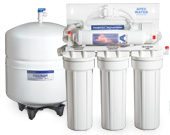What really
happened to our tap water and underground water?
Clean
water is one of the most important needs of our bodies. It is a sad fact
that something as essential to life as clean drinking water can no longer
be granted to us. Unsafe water is not just a third world problem. In fact,
safe drinking water is even harder to find specially in industrially developed
countries such as the U.S.
Can we
depend on bottled water then?
The fact is that bottled water sold in the United States is not always
filtered and not necessarily cleaner or safer than most tap water, according
to a four-year scientific study recently made public by the Natural Resources
Defense Council (NRDC).
The NRDC's study included testing of more than 1,000 bottles of 103 brands
of bottled water. While most of the tested waters were found to be of
high quality, some brands were significantly contaminated.
About one-third of the waters tested contained levels of contamination
including synthetic organic chemicals, bacteria, and arsenic (at least
one sample exceeded allowable limits under either state or bottled water
industry standards or guidelines).
In fact, about a quarter of all bottled water is actually bottled tap
water, according to government and industry estimates (some estimates
go as high as 40 percent).
To
Be Sure: Protect yourself with a High Quality Water Filter
A good water filter is the best and maybe the only solution nowadays.
You can install and maintain the filters yourself and can ensure and feel
safe about the water which you and your family drink. Just make sure the
filter you choose removes the most spectrum of contaminants. Usually a
professional filtration system worth invest-in is a 4 to 5 stage water
purifier system. Each stage will remove certain types of contaminants,
and all stages combined should protect you from just about every contaminant.
A reverse osmosis water filter
with activated carbon pre-filters, plus an ultraviolet light, are
what we believe to be the most thorough and cost effective way to purify
drinking water. Such a system will pay for itself within half a year
and can last 10-15 years with easy annual filter changes.

Some more facts:
| There are 35,000 pesticides containing 600 chemical compounds. Yet municipal water systems are only required to test for six. Many of these chemicals are known to cause birth defects, nerve damage, sterility and cancer. |
| The General Accounting Office reports that 20% of the nation's 65,000 community systems are unable to meet minimum standards set by the Safe Drinking Water Act. |
| More than 700 organic chemicals have been identified in drinking water, and some of them are suspected cancer causing agents. |
| A recent government study found that more than 25% of all large U.S. public water systems contain traces of one or more toxic substances. ... Public water systems do not test for the carcinogens and other dangerous chemicals that are being found. |